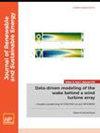Photosynthetically active radiation separation model for high-latitude regions in agrivoltaic systems modeling
IF 1.9
4区 工程技术
Q4 ENERGY & FUELS
引用次数: 0
Abstract
Photosynthetically active radiation is a key parameter for determining crop yield. Separating photosynthetically active radiation into direct and diffuse components is significant to agrivoltaic systems. The varying shading conditions caused by the solar panels produce a higher contribution of diffuse irradiance reaching the crops. This study introduces a new separation model capable of accurately estimating the diffuse component from the global photosynthetically active radiation and conveniently retrievable meteorological parameters. The model modifies one of the highest-performing separation models for broadband irradiance, namely, the Yang2 model. Four new predictors are added: atmospheric optical thickness, vapor pressure deficit, aerosol optical depth, and surface albedo. The proposed model has been calibrated, tested, and validated at three sites in Sweden with latitudes above 58 °N, outperforming four other models in all examined locations, with R2 values greater than 0.90. The applicability of the developed model is demonstrated using data retrieved from Sweden's first agrivoltaic system. A variety of data availability cases representative of current and future agrivoltaic systems is tested. If on-site measurements of diffuse photosynthetically active radiation are not available, the model calibrated based on nearby stations can be a suitable first approximation, obtaining an R2 of 0.89. Utilizing predictor values derived from satellite data is an alternative method, but the spatial resolution must be considered cautiously as the R2 dropped to 0.73.农业光伏系统建模中的高纬度地区光合辐射分离模型
光合有效辐射是决定作物产量的关键参数。将光合有效辐射分为直接辐射和漫射辐射对农业光伏系统非常重要。太阳能电池板造成的不同遮阳条件会使到达作物的漫射辐射量增加。本研究引入了一种新的分离模型,能够从全球光合有效辐射和方便检索的气象参数中准确估算漫射部分。该模型修改了宽带辐照度性能最高的分离模型之一,即 Yang2 模型。增加了四个新的预测因子:大气光学厚度、水汽压差、气溶胶光学深度和地表反照率。在瑞典纬度高于 58 °N 的三个地点对所提出的模型进行了校准、测试和验证,在所有考察地点,该模型都优于其他四个模型,R2 值大于 0.90。瑞典首个农业光伏系统提供的数据证明了所开发模型的适用性。对代表当前和未来农业光伏系统的各种数据可用性情况进行了测试。如果无法现场测量漫射光合有效辐射,根据附近站点校准的模型可以作为合适的第一近似值,R2 为 0.89。利用卫星数据得出的预测值是一种替代方法,但必须谨慎考虑空间分辨率,因为 R2 降至 0.73。
本文章由计算机程序翻译,如有差异,请以英文原文为准。
求助全文
约1分钟内获得全文
求助全文
来源期刊

Journal of Renewable and Sustainable Energy
ENERGY & FUELS-ENERGY & FUELS
CiteScore
4.30
自引率
12.00%
发文量
122
审稿时长
4.2 months
期刊介绍:
The Journal of Renewable and Sustainable Energy (JRSE) is an interdisciplinary, peer-reviewed journal covering all areas of renewable and sustainable energy relevant to the physical science and engineering communities. The interdisciplinary approach of the publication ensures that the editors draw from researchers worldwide in a diverse range of fields.
Topics covered include:
Renewable energy economics and policy
Renewable energy resource assessment
Solar energy: photovoltaics, solar thermal energy, solar energy for fuels
Wind energy: wind farms, rotors and blades, on- and offshore wind conditions, aerodynamics, fluid dynamics
Bioenergy: biofuels, biomass conversion, artificial photosynthesis
Distributed energy generation: rooftop PV, distributed fuel cells, distributed wind, micro-hydrogen power generation
Power distribution & systems modeling: power electronics and controls, smart grid
Energy efficient buildings: smart windows, PV, wind, power management
Energy conversion: flexoelectric, piezoelectric, thermoelectric, other technologies
Energy storage: batteries, supercapacitors, hydrogen storage, other fuels
Fuel cells: proton exchange membrane cells, solid oxide cells, hybrid fuel cells, other
Marine and hydroelectric energy: dams, tides, waves, other
Transportation: alternative vehicle technologies, plug-in technologies, other
Geothermal energy
 求助内容:
求助内容: 应助结果提醒方式:
应助结果提醒方式:


